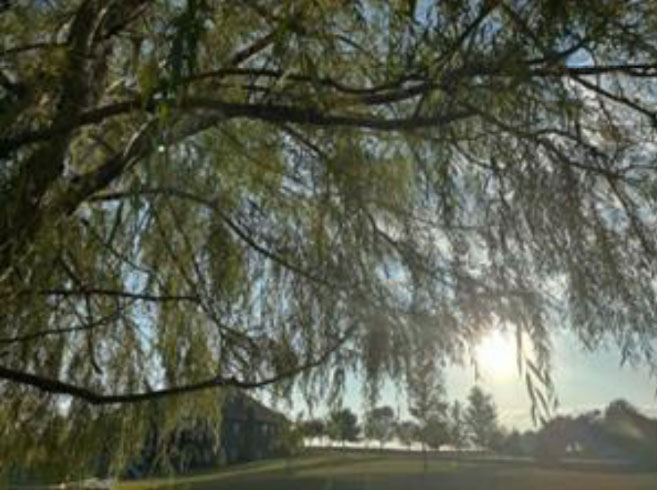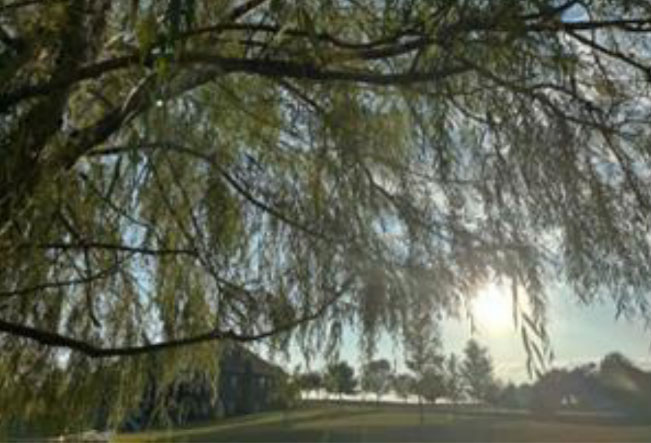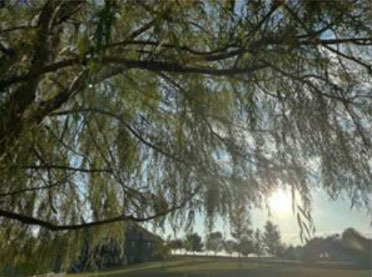
Willow Wonders: A Tree-mendous Tale of Science and Magic
By Kenyon Geetings ’24
LAS 410: Exploring Ecotones: Literature, Science, and History
The LAS 410 seminar applauded this author’s writing style as well as ability to integrate science, literature, history, and word play. We also loved this presentation he created to present to the seventh graders for “Willow Wonders: A Tree-mendous Tale of Science and Magic.”
-Dr. Mary Stark

In the field of botany, there exists a group of arboreal wonders that captivate both the scientist and the dreamer alike. Among these, the Salix babylonica, commonly known as the weeping willow, stands as an emblem of enchantment. Its scientific name, a poetic melody in itself, conceals a world of mystery and fascination waiting to be unveiled.
The scientific name Salix babylonica follows the standard binomial nomenclature system established by Carl Linnaeus in the 18th century. In this system, the genus name (Salix) is followed by the species name (babylonica). The genus Salix encompasses a wide variety of willow species, and each species has its own unique scientific name. The term “babylonica” in Salix babylonica doesn’t directly reference the ancient city of Babylon. Instead, it is believed to be a reference to the tree’s resemblance to the willow trees that were common along the Euphrates River in ancient Mesopotamia, where the city of Babylon was located (Burton 140). This similarity in appearance likely led to the choice of the species name. The weeping willow, with its graceful, drooping branches, has captivated the human imagination for centuries. Its melancholic appearance has often been associated with themes of sorrow and mourning. In various cultures, willow trees have symbolized sadness, reflection, and even the passage of time. One such example is poignantly echoed in Psalm 137 which begins “By the rivers of Babylon, there we sat down, yea, we wept, when we remembered Zion. We hanged our harps upon the willows in the midst thereof” (Holy Bible King James Version, Ps. 137 1.1-2). This cultural significance may have influenced the choice of the term “babylonica” as well, as it evokes a sense of nostalgia and contemplation.

As I stand beneath the graceful canopy of a majestic willow tree, I am transported to a place where science and magic intertwine. The slender branches, like cascading locks of a sylvan god, gracefully sweep the earth, a living curtain veiling secrets of the natural world. In the dappled sunlight beneath its boughs, life thrives, and a diverse community of creatures flourishes.
Scientifically, this arboreal wonder is a deciduous tree, belonging to the genus Salix in the family Salicaceae. But to merely label it as such is to miss the symphony of life that dances in its presence. The weeping willow is, in essence, a sanctuary for biodiversity. Its sinuous branches provide refuge and sustenance to an array of avian residents like the American Robin (Turdus migratorius), the Marsh Wren (Cistothorus palustris) and pictured here, the White-breasted nuthatch (Sitta carolinensis) (Shaw). As I gaze upon the intricate nests woven amid the willow’s tendrils, I marvel at the delicate architecture of nature itself.
But it’s not only the avian world that seeks solace within the embrace of the Salix babylonica. The rich ecosystem beneath its boughs teems with life. Beneath the surface, roots reach out like searching fingers, drawing sustenance from the Earth. This grand tree offers a haven to innumerable microorganisms and fungi, engaged in a subterranean dance of nutrient exchange. A symphony of life hidden from the casual observer, unveiling the profound interconnectedness of the natural world.
 In the midst of my reverie, a gentle breeze stirs the leaves above, and the signature rustling of the willow, like nature’s lullaby, fills the air. The weeping willow’s leaves, elliptical and green in the spring, transition to a vibrant yellow in autumn, as if the tree itself were shedding tears of pure gold. It’s a transformation that speaks of the changing seasons, a timeless reminder of nature’s eternal rhythm (Rovelli 18).
In the midst of my reverie, a gentle breeze stirs the leaves above, and the signature rustling of the willow, like nature’s lullaby, fills the air. The weeping willow’s leaves, elliptical and green in the spring, transition to a vibrant yellow in autumn, as if the tree itself were shedding tears of pure gold. It’s a transformation that speaks of the changing seasons, a timeless reminder of nature’s eternal rhythm (Rovelli 18).
In Iowa, as in many other parts of the United States, the weeping willow has become an integral part of the landscape. Its elegant form and serene demeanor make it a beloved tree for parks, gardens, and residential areas. It thrives in Iowa’s climate, with its long, cold winters and warm summers, and has adapted well to the region. Beyond its aesthetic value, the weeping willow also plays a role in environmental conservation in Iowa. Its extensive root system helps prevent soil erosion along riverbanks and streams, making it an ideal choice for riparian areas. Furthermore, the tree’s ability to filter pollutants from water and provide habitat for wildlife contributes to the overall health of Iowa’s ecosystems. The weeping willow’s presence in Iowa symbolizes a connection between the state’s natural beauty and its people. It serves as a reminder of the importance of preserving and appreciating the rich biodiversity that Iowa’s landscapes offer.

Fig. 1. Underground wood wide web
Shifting focus back beneath the surface of the weeping willow’s sweeping branches lies a concealed network of life that transcends our understanding of individual trees. It is a domain where the boundaries between roots blur, and communication takes on a language more ancient than words—the Wood Wide Web of mycorrhizal fungi (mycorrhiza).
This intricate underground network, often referred to as the “Internet of the Forest,” serves as nature’s own social media platform for trees (Rhodes 331). Mycorrhizal fungi form symbiotic relationships with tree roots, extending their reach far beyond what any single tree could achieve on its own. Through this vast fungal web, trees can communicate, share resources, and support one another.
But do willow trees, with their poetic and melancholic presence, partake in this silent symphony of communication beneath the forest floor? The answer, indeed, is a resounding yes. Willow trees are active participants in the Wood Wide Web, demonstrating the interconnectedness of all life in the forest. Within the embrace of a willow’s roots, mycorrhizal fungi bridge the gap between trees. They facilitate the exchange of essential nutrients, like nitrogen and phosphorus, between different species of trees, enhancing the overall health of the forest community (Becard 84). The willow, with its extensive root system, is particularly adept at nurturing these fungal connections, making it a vital contributor to the Wood Wide Web.
As I stand here beneath the willow’s drooping boughs, I can’t help but marvel at the idea that these majestic trees are not solitary beings, but rather integral members of a forest community that communicates and cooperates beneath the surface. It’s a testament to the deep interdependence of life on our planet, a reminder that no being exists in isolation.

Now, let’s turn our attention to the Global Goals for sustainable development, as outlined by Project Everyone. These goals serve as a compass for responsible stewardship of our planet, urging us to protect and nurture the environment upon which all life depends (Goals Archive). Willow trees, with their unique attributes, contribute significantly to several of these global goals.
Goal 13, “Climate Action,” calls for efforts to combat climate change and its impacts. Willow trees play a crucial role in this endeavor. Their rapid growth and extensive root systems make them excellent carbon sequestration champions. By absorbing carbon dioxide from the atmosphere and storing it in their biomass and the soil, willow trees help mitigate the effects of climate change (Gorobets 4).
Furthermore, Goal 15, “Life on Land,” emphasizes the need to protect and restore ecosystems and halt biodiversity loss. It explicitly highlights that “flourishing life on land is the foundation for our life on this planet” with the target of incentivizing sustainable forest management (Goals Archive). Willow trees, with their ability to create habitat for a diverse range of wildlife, contribute directly to this goal. Under their sheltering branches, birds build their nests, insects find refuge, and countless other creatures find sustenance. By preserving and planting willow trees, we can enhance the biodiversity of our landscapes.
 In the shade of the weeping willow, I find not only solace but also inspiration. It reminds me that, like the trees in the forest, we are part of a larger web of life. It’s a web that calls us to act, to protect, and to preserve—a web that extends far beyond the branches of a single tree, encompassing the entire world.
In the shade of the weeping willow, I find not only solace but also inspiration. It reminds me that, like the trees in the forest, we are part of a larger web of life. It’s a web that calls us to act, to protect, and to preserve—a web that extends far beyond the branches of a single tree, encompassing the entire world.
As I reflect on these global goals, I can’t help but see a parallel between the interconnectedness of the Wood Wide Web and our shared responsibility to care for our planet. Just as the mycorrhizal fungi facilitate the exchange of resources between trees, so too must we facilitate the exchange of knowledge and action between nations and individuals to achieve these global goals.
As I take in the grandeur of this willow tree, I realize that scientific names and classifications, though necessary for understanding, do not capture the essence of this living marvel. The weeping willow transcends the confines of nomenclature. It is an embodiment of life’s wonder, a testament to the meaningful bonds that underlie our world.
In the realm of the willow tree, science and poetry converge, reminding us of the inexhaustible wonders that surround us. This weeping willow, with its scientific name as intricate as its biology, beckons us to look closer, to embrace the sense of wonder that lies within our reach. In the shade of its branches, we find not only shade from the sun but also a profound connection to the intricate web of life that binds us all.
Works Cited
Becard, Guillaume. “Plant–Plant Communication Through Common Mycorrhizal Networks.” How Plants Communicate with Their Biotic Environment, vol. 82, Academic Press, London, 2017, pp. 83–97.
Burton Verne Barnes, and Warren H Wagner. Michigan Trees a Guide to the Trees of the Great Lakes Region. Ann Arbor, Mich. University of Michigan Press, 2004.
“Goals Archive.” The Global Goals, Project Everyone, www.globalgoals.org/goals/. Accessed 9 Sept. 2023.
Gorobets, A, and M Silva. “Willow Communities, Optimal Absorption of Carbon Dioxide from the Atmosphere.” IOP Conference Series: Earth and Environmental Science, vol. 595, no. 1, 1 Nov. 2020, p. 012038, https://doi.org/10.1088/1755-1315/595/1/012038. Accessed 19 Sept. 2023.
Rhodes, Christopher J. “The whispering world of plants: ‘The Wood Wide Web’.” Science progress vol. 100,3 (2017): 331-337. doi:10.3184/003685017X14968299580423 Rovelli, Carlo, et al. The Order of Time. New York, Riverhead Books, 2018.
Shaw, Ethan. “Animals or Insects That Live in a Willow Tree.” eHow, Leaf Group, www.ehow.com/info_12090515_animals-insects-live-willow-tree.html. Accessed 19 Sept. 2023.
Holy Bible King James Version. Nelson Bibles, 2014.
Geetings, Kenyon. Underground wood wide web between willow trees. 19 Sept. 2023. Bing image Creator, Preview, Microsoft, https://www.bing.com/images/create/. Accessed 19 Sept. 2023.
Geetings, Kenyon. Photograph of Willow Tree.